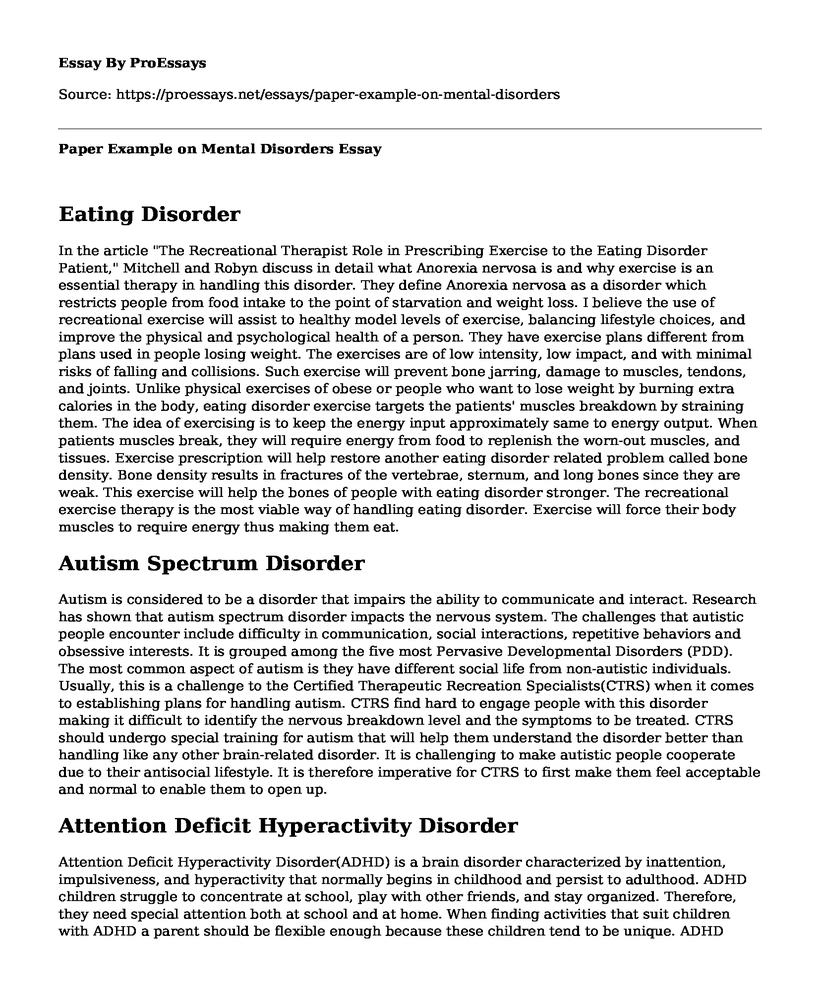Eating Disorder
In the article "The Recreational Therapist Role in Prescribing Exercise to the Eating Disorder Patient," Mitchell and Robyn discuss in detail what Anorexia nervosa is and why exercise is an essential therapy in handling this disorder. They define Anorexia nervosa as a disorder which restricts people from food intake to the point of starvation and weight loss. I believe the use of recreational exercise will assist to healthy model levels of exercise, balancing lifestyle choices, and improve the physical and psychological health of a person. They have exercise plans different from plans used in people losing weight. The exercises are of low intensity, low impact, and with minimal risks of falling and collisions. Such exercise will prevent bone jarring, damage to muscles, tendons, and joints. Unlike physical exercises of obese or people who want to lose weight by burning extra calories in the body, eating disorder exercise targets the patients' muscles breakdown by straining them. The idea of exercising is to keep the energy input approximately same to energy output. When patients muscles break, they will require energy from food to replenish the worn-out muscles, and tissues. Exercise prescription will help restore another eating disorder related problem called bone density. Bone density results in fractures of the vertebrae, sternum, and long bones since they are weak. This exercise will help the bones of people with eating disorder stronger. The recreational exercise therapy is the most viable way of handling eating disorder. Exercise will force their body muscles to require energy thus making them eat.
Autism Spectrum Disorder
Autism is considered to be a disorder that impairs the ability to communicate and interact. Research has shown that autism spectrum disorder impacts the nervous system. The challenges that autistic people encounter include difficulty in communication, social interactions, repetitive behaviors and obsessive interests. It is grouped among the five most Pervasive Developmental Disorders (PDD). The most common aspect of autism is they have different social life from non-autistic individuals. Usually, this is a challenge to the Certified Therapeutic Recreation Specialists(CTRS) when it comes to establishing plans for handling autism. CTRS find hard to engage people with this disorder making it difficult to identify the nervous breakdown level and the symptoms to be treated. CTRS should undergo special training for autism that will help them understand the disorder better than handling like any other brain-related disorder. It is challenging to make autistic people cooperate due to their antisocial lifestyle. It is therefore imperative for CTRS to first make them feel acceptable and normal to enable them to open up.
Attention Deficit Hyperactivity Disorder
Attention Deficit Hyperactivity Disorder(ADHD) is a brain disorder characterized by inattention, impulsiveness, and hyperactivity that normally begins in childhood and persist to adulthood. ADHD children struggle to concentrate at school, play with other friends, and stay organized. Therefore, they need special attention both at school and at home. When finding activities that suit children with ADHD a parent should be flexible enough because these children tend to be unique. ADHD makes children stick to a routine that they are passionate about. Therefore, it is the role of the parent to point out these activities. Both the articles and the book chapter outline the signs of ADHD, offer recommendations on activities that these children like, and the process of identifying the activities. Activities should be limited to distractions since they struggle to stay focused, aim at building their self-esteem, and it should be flexible enough to give room for change in case the child would not like it. Additude magazine suggests that after-school sports is recommend for ADHD person since it raises the baseline levels of dopamine and norepinephrine in the brain. Again, it is essential to take into considerations a choice of a coach. Coaches should be well informed enough that the child has ADHD disorder. Both articles outline the activities that suit best the ADHD children. Swimming will help a child focus on personal development. It is believed to have contributed to managing ADHD symptoms by keeping them disciplined and focused. Other activities include martial arts, scouting, team sports, and drama, art of music, and model building. Activities should target physical simulation, socially engaging, close adult supervision and should be highly structured. The articles and the book chapters are the primary guides to living with ADHD children. Personally, I will use the information to come with sustainable plans to help them succeed despite having a disorder.
Cite this page
Paper Example on Mental Disorders. (2022, Apr 07). Retrieved from https://proessays.net/essays/paper-example-on-mental-disorders
If you are the original author of this essay and no longer wish to have it published on the ProEssays website, please click below to request its removal:
- Essay Sample on The Structural Strain Theory
- Emotions Influence on Athletes and Teams Paper Example
- Distress and Depression in Diabetic Persons and Their Relationship With Self-Care Practitioners in Barbados
- Investigation of Behavioral Management Policies in School Paper Example
- Counselling Adults With Learning Disabilities Case Study Paper Example
- Research Paper on Sex Differences in Mental Abilities
- Annotated Bibliography on Effective Psychiatric Diagnosis & Treatment Planning for Kyle







